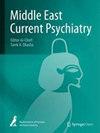Neurocognitive profiles in a community sample of children & adolescents: sociodemographic, behavioral and emotional correlates
IF 1.6
Q3 PSYCHIATRY
引用次数: 0
Abstract
We aim to investigate the association between cognitive profiles of children and adolescents, classified using latent class analysis and emotional, behavioral and sociodemographic factors in a community-based sample of children and adolescents. The sample consists of 161 participants recruited from a nationally representative household sample of 1517 children and adolescents who participated in a national mental health survey. Participants and their parents completed the following scales: Strengths and Difficulties Questionnaire, Mood and Feelings Questionnaire, and Screen for Child Anxiety Related Emotional Disorders. Participants were then administered a battery of cognitive tests from the Cambridge Automated Neuropsychological Assessment Battery as well as the Wechsler Nonverbal Scale of Ability. Latent class analysis showed a 2-class model that was stable and had good entropy (0.837). Class 1 included 58 participants (36.0%), and Class 2 included 103 participants (64.0%). Participants belonging to Class 1 performed better than those in Class 2 on all cognitive tasks. Chances for belonging to a specific Class varied based on different sociodemographic, behavioral and emotional factors: older participants with higher Intellectual Quotient, higher parental educational level, lower reported hyperactivity and better-reported mood were more likely to belong to Class 1. Our results show a tight correlation between different emotional, behavioral and sociodemographic variables on one hand and cognitive functioning in children and adolescents on the other hand. This supports the continuous need for an integrative approach when building norms for cognitive tests that account at the least for all these variables.社区儿童和青少年样本的神经认知特征:社会人口、行为和情绪相关性
我们的目的是在社区儿童和青少年样本中,研究使用潜类分析法分类的儿童和青少年认知特征与情绪、行为和社会人口因素之间的关联。样本由 161 名参与者组成,他们是从具有全国代表性的 1517 个儿童和青少年家庭样本中招募的,参加了一项全国心理健康调查。参与者及其父母填写了以下量表:优势和困难问卷、情绪和感觉问卷以及儿童焦虑相关情绪障碍筛查。然后,对参与者进行了剑桥自动神经心理评估电池和韦氏非语言能力量表的认知测试。潜类分析显示出一个稳定且熵值良好(0.837)的两类模型。第一类包括 58 名参与者(36.0%),第二类包括 103 名参与者(64.0%)。在所有认知任务中,1 类参与者的表现均优于 2 类参与者。根据不同的社会人口、行为和情绪因素,属于某一特定类别的几率也不同:年龄较大、智商较高、父母教育水平较高、多动报告较少和情绪报告较好的参与者更有可能属于类别 1。我们的研究结果表明,不同的情绪、行为和社会人口变量与儿童和青少年的认知功能密切相关。这表明,在制定认知测试标准时,仍然需要采用综合方法,至少要考虑到所有这些变量。
本文章由计算机程序翻译,如有差异,请以英文原文为准。
求助全文
约1分钟内获得全文
求助全文
来源期刊

Middle East Current Psychiatry
Medicine-Psychiatry and Mental Health
CiteScore
3.00
自引率
0.00%
发文量
89
审稿时长
9 weeks
 求助内容:
求助内容: 应助结果提醒方式:
应助结果提醒方式:


